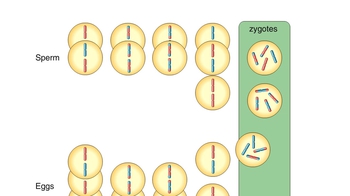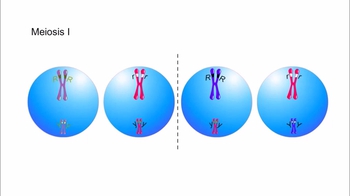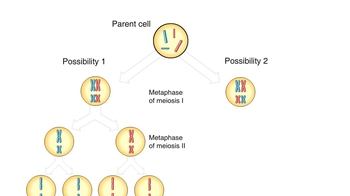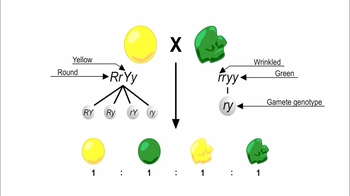Table of contents
- 1. Introduction to Biology2h 42m
- 2. Chemistry3h 40m
- 3. Water1h 26m
- 4. Biomolecules2h 23m
- 5. Cell Components2h 26m
- 6. The Membrane2h 31m
- 7. Energy and Metabolism2h 0m
- 8. Respiration2h 40m
- 9. Photosynthesis2h 49m
- 10. Cell Signaling59m
- 11. Cell Division2h 47m
- 12. Meiosis2h 0m
- 13. Mendelian Genetics4h 44m
- Introduction to Mendel's Experiments7m
- Genotype vs. Phenotype17m
- Punnett Squares13m
- Mendel's Experiments26m
- Mendel's Laws18m
- Monohybrid Crosses19m
- Test Crosses14m
- Dihybrid Crosses20m
- Punnett Square Probability26m
- Incomplete Dominance vs. Codominance20m
- Epistasis7m
- Non-Mendelian Genetics12m
- Pedigrees6m
- Autosomal Inheritance21m
- Sex-Linked Inheritance43m
- X-Inactivation9m
- 14. DNA Synthesis2h 27m
- 15. Gene Expression3h 20m
- 16. Regulation of Expression3h 31m
- Introduction to Regulation of Gene Expression13m
- Prokaryotic Gene Regulation via Operons27m
- The Lac Operon21m
- Glucose's Impact on Lac Operon25m
- The Trp Operon20m
- Review of the Lac Operon & Trp Operon11m
- Introduction to Eukaryotic Gene Regulation9m
- Eukaryotic Chromatin Modifications16m
- Eukaryotic Transcriptional Control22m
- Eukaryotic Post-Transcriptional Regulation28m
- Eukaryotic Post-Translational Regulation13m
- 17. Viruses37m
- 18. Biotechnology2h 58m
- 19. Genomics17m
- 20. Development1h 5m
- 21. Evolution3h 1m
- 22. Evolution of Populations3h 52m
- 23. Speciation1h 37m
- 24. History of Life on Earth2h 6m
- 25. Phylogeny2h 31m
- 26. Prokaryotes4h 59m
- 27. Protists1h 12m
- 28. Plants1h 22m
- 29. Fungi36m
- 30. Overview of Animals34m
- 31. Invertebrates1h 2m
- 32. Vertebrates50m
- 33. Plant Anatomy1h 3m
- 34. Vascular Plant Transport1h 2m
- 35. Soil37m
- 36. Plant Reproduction47m
- 37. Plant Sensation and Response1h 9m
- 38. Animal Form and Function1h 19m
- 39. Digestive System1h 10m
- 40. Circulatory System1h 57m
- 41. Immune System1h 12m
- 42. Osmoregulation and Excretion50m
- 43. Endocrine System1h 4m
- 44. Animal Reproduction1h 2m
- 45. Nervous System1h 55m
- 46. Sensory Systems46m
- 47. Muscle Systems23m
- 48. Ecology3h 11m
- Introduction to Ecology20m
- Biogeography14m
- Earth's Climate Patterns50m
- Introduction to Terrestrial Biomes10m
- Terrestrial Biomes: Near Equator13m
- Terrestrial Biomes: Temperate Regions10m
- Terrestrial Biomes: Northern Regions15m
- Introduction to Aquatic Biomes27m
- Freshwater Aquatic Biomes14m
- Marine Aquatic Biomes13m
- 49. Animal Behavior28m
- 50. Population Ecology3h 41m
- Introduction to Population Ecology28m
- Population Sampling Methods23m
- Life History12m
- Population Demography17m
- Factors Limiting Population Growth14m
- Introduction to Population Growth Models22m
- Linear Population Growth6m
- Exponential Population Growth29m
- Logistic Population Growth32m
- r/K Selection10m
- The Human Population22m
- 51. Community Ecology2h 46m
- Introduction to Community Ecology2m
- Introduction to Community Interactions9m
- Community Interactions: Competition (-/-)38m
- Community Interactions: Exploitation (+/-)23m
- Community Interactions: Mutualism (+/+) & Commensalism (+/0)9m
- Community Structure35m
- Community Dynamics26m
- Geographic Impact on Communities21m
- 52. Ecosystems2h 36m
- 53. Conservation Biology24m
12. Meiosis
Genetic Variation During Meiosis
Problem 2`
Textbook Question
What is an outcome of genetic recombination?
a. The synapsing of homologs during prophase of meiosis I
b. The new combination of maternal and paternal chromosome segments that results when homologs cross over
c. The new combinations of chromosome segments that result when self-fertilization occurs
d. The combination of a haploid phase and a diploid phase in a life cycle
 Verified step by step guidance
Verified step by step guidance1
Understand the concept of genetic recombination: Genetic recombination is a process during which genetic material is rearranged, resulting in new combinations of alleles. This typically occurs during meiosis, specifically in prophase I, when homologous chromosomes pair up and exchange segments.
Analyze option a: The synapsing of homologs during prophase of meiosis I refers to the pairing of homologous chromosomes, which is a prerequisite for recombination but not the outcome itself.
Analyze option b: The new combination of maternal and paternal chromosome segments that results when homologs cross over is a direct outcome of genetic recombination. During crossing over, segments of DNA are exchanged between homologous chromosomes, creating new allele combinations.
Analyze option c: The new combinations of chromosome segments that result when self-fertilization occurs is not directly related to genetic recombination. Self-fertilization involves the fusion of gametes from the same individual, which may not necessarily involve recombination.
Analyze option d: The combination of a haploid phase and a diploid phase in a life cycle describes the alternation of generations, which is a broader concept in biology and not specifically an outcome of genetic recombination.
 Verified video answer for a similar problem:
Verified video answer for a similar problem:This video solution was recommended by our tutors as helpful for the problem above
Video duration:
3mPlay a video:
Was this helpful?
Key Concepts
Here are the essential concepts you must grasp in order to answer the question correctly.
Genetic Recombination
Genetic recombination is a process during meiosis where homologous chromosomes exchange genetic material. This occurs during prophase I of meiosis through a mechanism called crossing over. The result is a new combination of alleles on each chromosome, increasing genetic diversity in the offspring.
Recommended video:

Sexual Reproduction and Recombination
Crossing Over
Crossing over is a crucial event in meiosis where homologous chromosomes pair up and exchange segments of their genetic material. This process occurs during prophase I and leads to genetic variation by producing new combinations of alleles, which are different from those found in either parent.
Recommended video:
Guided course

Monohybrid Crosses
Homologous Chromosomes
Homologous chromosomes are pairs of chromosomes in a diploid organism that have the same structure and gene sequence, one inherited from each parent. During meiosis, these chromosomes pair up and can exchange genetic material through crossing over, contributing to genetic diversity in gametes.
Recommended video:
Guided course
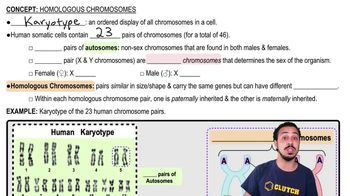
Homologous Chromosomes

 7:08m
7:08mWatch next
Master Genetic Variation During Meiosis with a bite sized video explanation from Jason
Start learningRelated Videos
Related Practice






